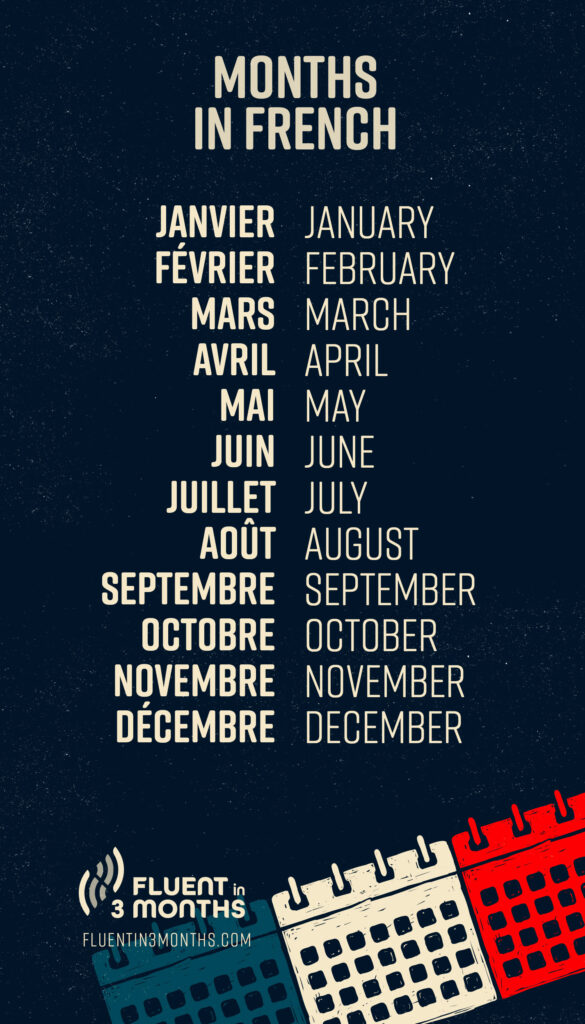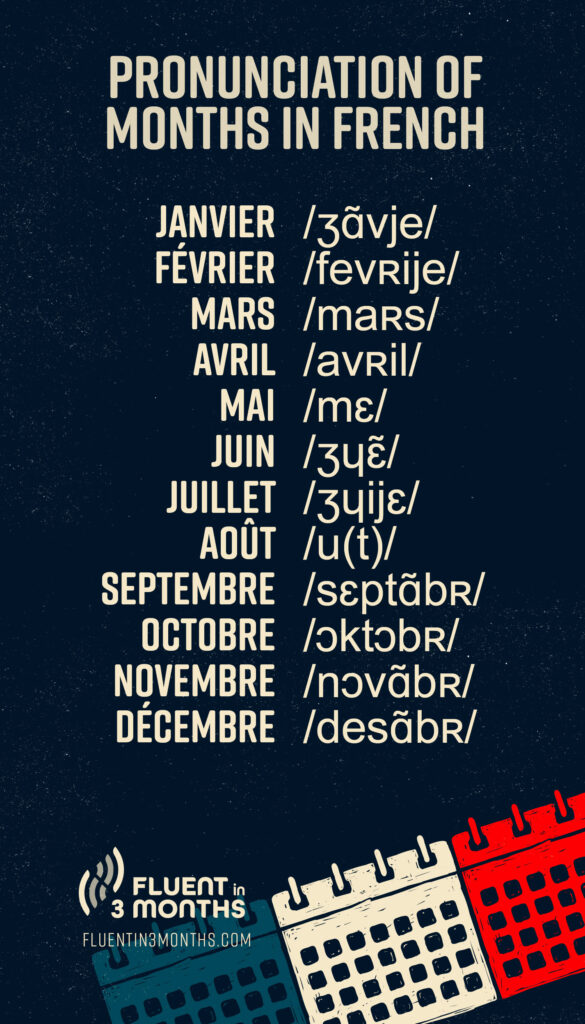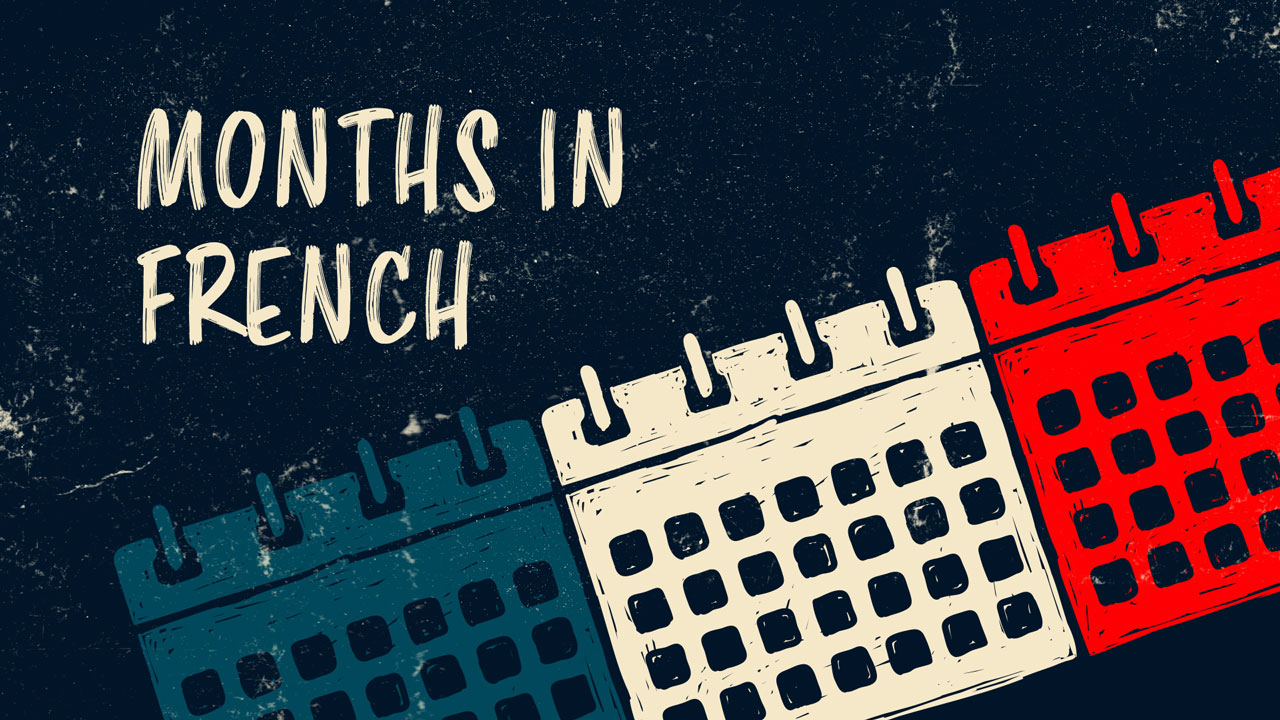Months in French: A Guide to Mastering the French Calendar
Months in French are similar to English. Learners often pick them up pretty quickly. But what about the pronunciation, spelling, and cultural significance of French months?
When I was studying in Lyon, France, I was part of the international student association. I got to attend some cool cultural events — I ate delicious crêpes during la Chandeleur, visited Christmas Markets in the city centre, and enjoyed Christmas dinner with a French family who was super kind to host me. While having these amazing experiences, I became fluent in French and lived my best French months!
In this article, I’ll start by covering the months’ names in French and move on with what happens in each month.
Table of contents
The Months of the Year in French: Les Mois de l’Année
Here’s a list of all the 12 months in French:
- Janvier: “January”
- Février: “February”
- Mars: “March”
- Avril: “April”
- Mai: “May”
- Juin: “June”
- Juillet: “July”
- Août: “August”
- Septembre: “September”
- Octobre: “October”
- Novembre: “November”
- Décembre: “December”

As you may have noticed, French months look and sound a lot like their English counterparts. That’s thanks to the shared Latin roots of these words. This might make it easier to remember the words, although you’ll still need to pay attention to their pronunciations and spelling. More on that soon!
Pronunciation of Les Mois de l’Année
Although they are similar to the English months, French months have distinct pronunciations. For example, the ai in mai sounds like the “e” in “bed,” and not like the “ay” sound in the English “May.”
And août — although it has three vowels, it only produces a “oo” sound similar to the “oo” in “boot.”
Here is the International Phonetic Alphabet pronunciation of each month:
- Janvier: (/ʒɑ̃vje/)
- Février: (/fevʀije/)
- Mars: (/maʀs/)
- Avril: (/avʀil/)
- Mai: (/mɛ/)
- Juin: (/ʒɥɛ̃/)
- Juillet: (/ʒɥijɛ/)
- Août: (/u(t)/)
- Septembre: (/sɛptɑ̃bʀ/)
- Octobre: (/ɔktɔbʀ/)
- Novembre: (/nɔvɑ̃bʀ/)
- Décembre: (/desɑ̃bʀ/)

Make sure to listen to their pronunciations and repeat them out loud. This way, you’ll improve your French pronunciation quickly. Take a look at our favourite French resources for some inspiration.
Example Sentences Featuring Months in French
Now that you know the months’ names in French, let’s practise them with some questions and prompts.
- Quel est ton mois préféré?: “What is your favorite month?”
- J’adore novembre car le Beaujolais nouveau arrive en novembre. “I love November because the new Beaujolais wine arrives in November.”
- J’aime bien mars parce que c’est mon anniversaire: “I like March because it’s my birthday.”
- C’est quand ton anniversaire?: “When is your birthday?”
- Mon anniversaire est en juillet: “My birthday is in July.”
- Quand est-ce que vous partez en vacances?: “When do you go on vacation?”
- On part en vacances en août.: “We go on vacation in August.”
- Quel mois préfères-tu pour voyager?: “Which month do you prefer for travelling?”
- J’aime bien voyager en octobre. Les températures sont agréables et il y a moins de touristes: “I like to travel in October. The temperatures are pleasant, and there are fewer tourists.”
- Quel mois es-tu le plus occupé(e)?: “In which month are you the busiest?”
- Je suis le plus occupé(e) en septembre parce que mes cours commencent: “I am the busiest in September because my classes start.”
- Quel mois est le plus chaud dans ton pays?: “What is the warmest month in your country?”
- Juillet est le mois le plus chaud: “July is the warmest month.”
Notice how the preposition “en” is used in French to say “in” before the months. Also, all French months are masculine. This means that you’ll need to make your adjective agreements accordingly. For example, in le mois de février est froid (“the month of February is cold”), froid is written in the masculine form.
Unlike English, French months are always written in lowercase unless they’re in the beginning of a sentence.
Other Ways of Practising French Months
- Set your smartphone and your computer to French. This way, you’ll see months every time you check your devices. 30 days per year — not bad!
- Speak as much as possible. We talk about months all the time while discussing everyday topics. It may even be useful for small talk. Start by saying Février a été plus froid que janvier, “February was colder than January,” and see where classic weather small talk takes you!
- Embrace French culture. Learning the months by heart isn’t difficult but what about actually living them as the French would do? French food is your perfect starting point. Let’s start with the very first week of January, which is the time for galette de roi, known in English as “king cake.” A round flaky pastry, galette de roi has a fève (a small trinket) hidden inside. Everyone takes a slice, and the person who discovers it becomes le roi (“the king”) or la reine (“the queen”). Why not try and organise a galette de roi this January?
French Cultural Events in Each Month
Culture shapes language, and French is no exception. For example, Poisson d’avril is the French expression for “April Fools Day.” Poisson is “fish” in French, so for April Fools, French children often make paper fish and stick it on their classmates’ backs! Let’s take a look at what else happens in each month.
Janvier
In January, there’s Jour de l’An, “New Year’s Day.” It’s a public holiday. Right after New Year’s Day, for the Epiphany, it’s time to choose the kings and the queens. In other words, it’s time for galette du roi.
Février
La Saint Valentin or “Valentine’s Day” is the perfect opportunity to say “je t’aime” to your loved one. On the second of February, there’s la Chandeleur, “Candlemas.” It’s customary to eat crêpes, both sweet and savoury.
Mars
Carnivals in Nice and Dunkirk start in January and February, and last well into March. Every year, there are colorful shows, glamorous floats, and parades.
Avril-Mai
Poisson d’Avril: time to plan a prank and have a good laugh with (or at!) your friends. The weather also starts getting warmer, so it’s perfect to go to a park to enjoy some French wine and cheese over a picnic.
Juin
Celebrated on June 21st, La Fête de la Musique (“World Music Day”) was created by the French culture department in 1982. Today, over 100 countries celebrate it with free concerts. Both professional and amateur musicians sing and play, as music unites everyone around them.
Juillet
July 14th marks Bastille Day, which is France’s national day, commemorating the French Revolution. You’ll see parades, fireworks, and parties throughout the country.
Août-Septembre
As summer ends, students go back to school in September. In French, this period is called la rentrée.
Octobre-Novembre
Another public holiday, La Toussaint is French for “All Saints’ Day.”
Décembre
December means Christmas, and of course, Christmas markets, marchés de Noël. Get in the festive vibes as you warm up with some vin chaud (“mulled wine”) or chocolat chaud (“hot chocolate”). Strasbourg, a city in France’s Alsace region, is known as the Capital of Christmas.
Learn and Live French Months!
Whether you change your phone’s language to French or you book a flight to Paris to enjoy the World Music Day, immersing yourself in French months will be fun. Go beyond memorising janvier, février, mars… and enjoy the experience!'



Social